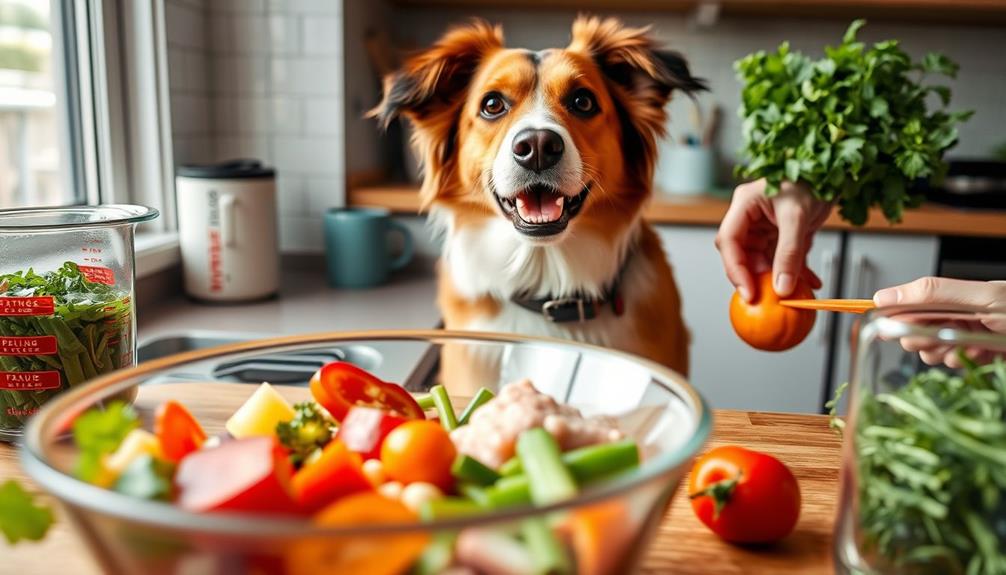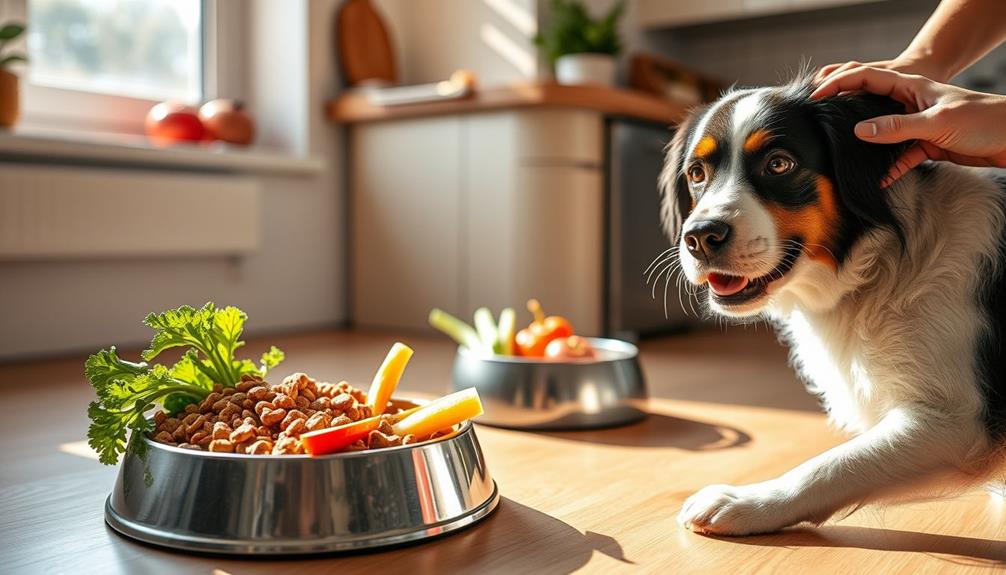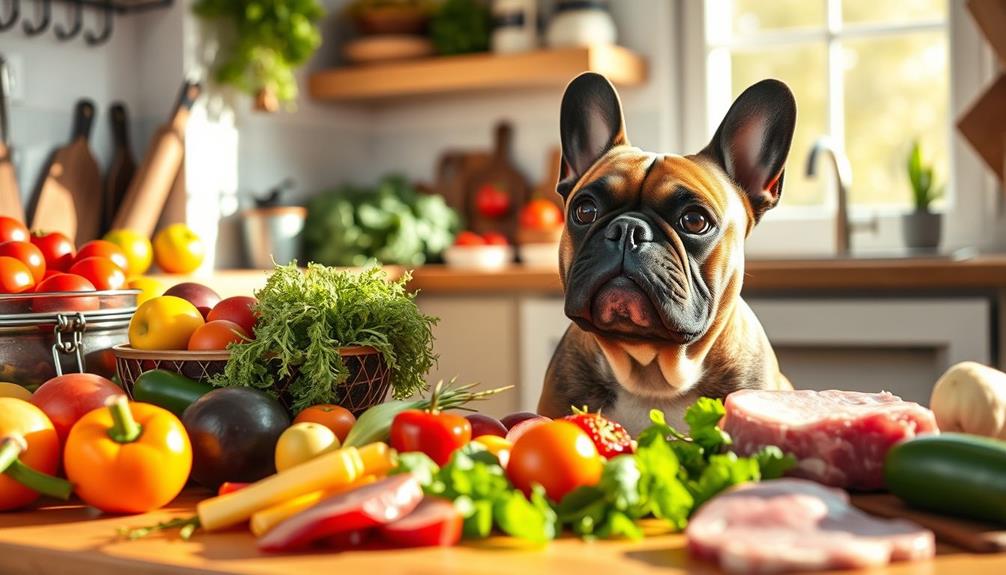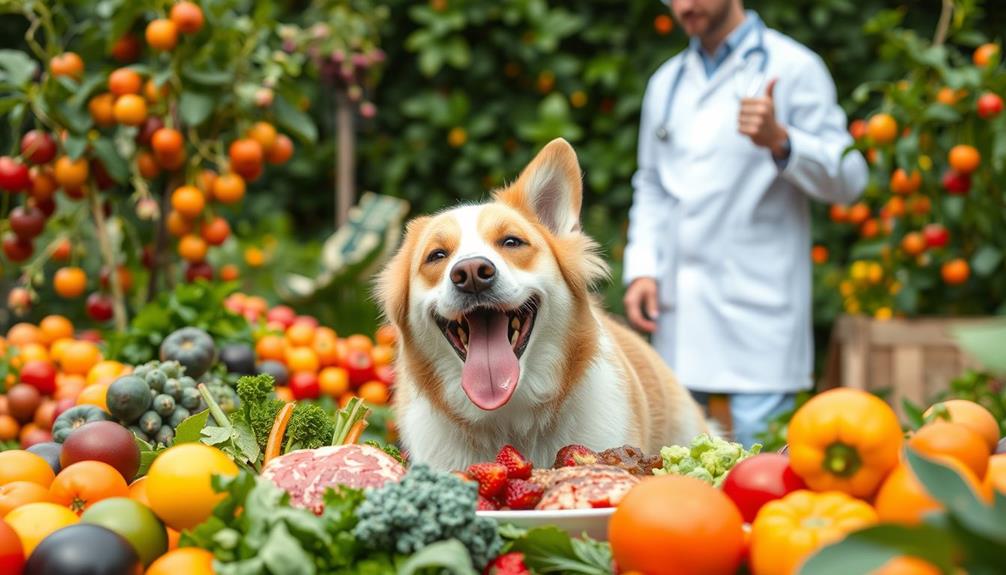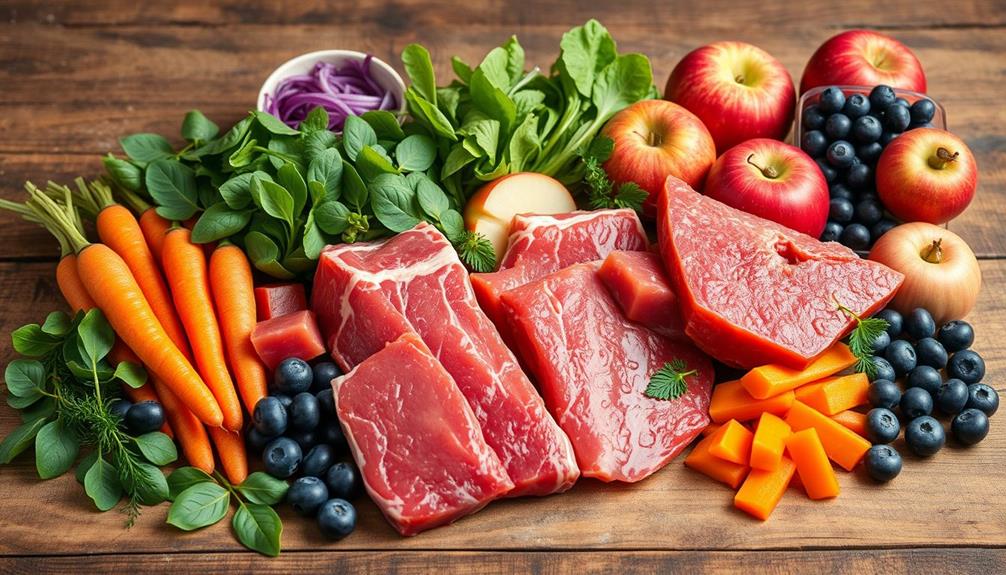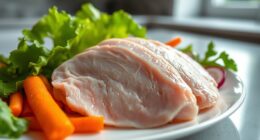To shift your dog to raw food, start gradually over 7 to 10 days. Mix 75% of their old food with 25% raw food, and slowly increase the raw portion. Monitor their appetite and stool consistency during this time. You can also introduce raw meals separately, keeping some kibble for other meals. Guarantee they have constant access to fresh water and watch for any digestive upset. Adding flavor enhancers like bone broth can make meals more enticing. Patience is key, and as you adjust their diet, you'll discover more tips for a successful shift. Switching your dog to raw food can have numerous benefits for their overall health and well-being. It’s important to consult with a veterinarian or a pet nutritionist to ensure that your dog’s new diet is balanced and meeting all their nutritional needs. Additionally, be mindful of any allergies or sensitivities your dog may have when introducing new types of raw food. Gradually transitioning your dog to a raw food diet can help minimize the risk of any digestive issues and make the switch a smooth and successful one.
Key Takeaways
- Gradually transition over 7 to 10 days, starting with 75% old food and 25% raw food to avoid digestive upset.
- Monitor your dog's appetite and stool consistency throughout the transition process for any adverse reactions.
- Use the Treat First Switch or Separate Meals Approach to introduce raw food gradually, increasing the raw ratio over time.
- Enhance raw meals with flavor boosters like cheese or bone broth to make them more appealing during the transition.
- Ensure constant access to fresh water and monitor for detox symptoms, consulting a veterinarian if severe issues arise.
Understanding the Transition Process
Shifting your dog to a raw food diet is best done gradually over 7 to 10 days. Start with a mix of 75% old food and 25% raw food. This gradual change allows your dog's digestive system to adjust without overwhelming it.
During this time, you'll want to keep a close eye on how well your dog accepts the new food. Monitoring their appetite and any changes in stool consistency is essential for evaluating their adjustment. Offering healthy dog snacks can also help ease the change and keep your pet engaged with their new diet. It's important to choose snacks made from natural ingredients to complement the raw food diet.
It's not uncommon for dogs to experience detox symptoms, such as vomiting or loose stools, as their bodies adapt to the raw food diet. These symptoms are usually temporary, so don't panic if they occur.
Make certain your dog has access to fresh water throughout the change, as hydration needs may change with the introduction of moisture-rich raw food.
Consider meal skipping before introducing raw food; this can help build your dog's appetite and clear their digestive tract, making the change smoother.
Gradual Transition Methods
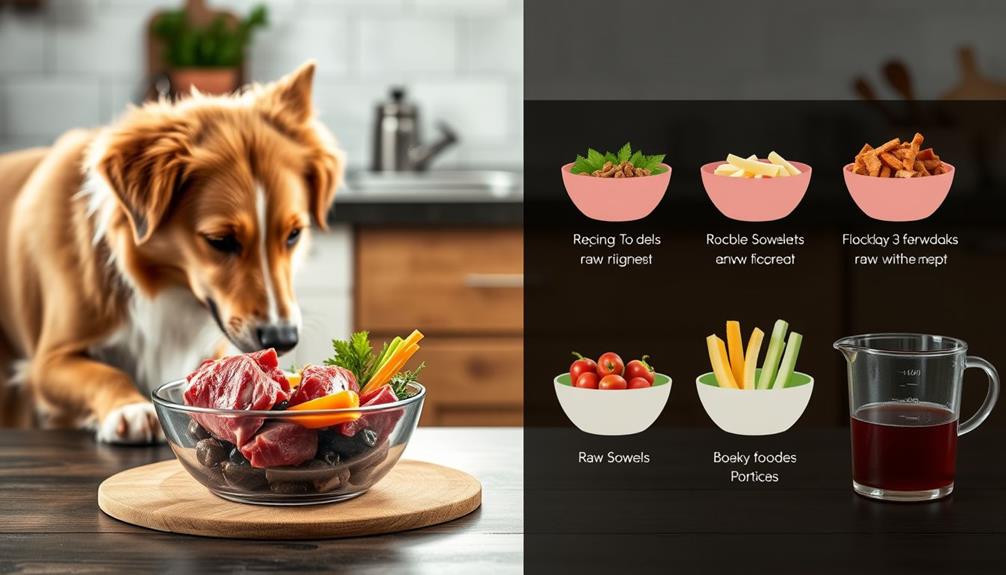
When shifting your dog to raw food, consider using methods like the Treat First Switch or the Separate Meals Approach.
These techniques let you introduce raw food gradually while monitoring your dog's response. It's also important to verify that the raw food is nutritionally balanced to support your dog's health, much like how ultimate hamster care emphasizes proper diet and nutrition for hamsters.
Treat First Switch
Introducing raw food to your dog can feel like a challenging task, but the Treat First Switch method makes it manageable and enjoyable. This approach allows you to gauge your dog's interest in raw food treats before fully incorporating them into their regular meals. Start by offering small pieces of raw food alongside their kibble. Gradually increase the amount of raw treats over several days.
Once your dog shows enthusiasm for these treats, replace one regular meal with raw food, beginning with a 25% raw and 75% kibble ratio. Use the table below to track the change:
| Days | Raw Food Ratio | Kibble Ratio |
|---|---|---|
| 1-2 | 25% | 75% |
| 3-4 | 50% | 50% |
| 5-6 | 75% | 25% |
| 7+ | 100% | 0% |
During this change period, monitor your dog's reaction closely. Adjust the ratios as necessary, especially for picky eaters or those with sensitive digestive systems, to guarantee a smooth and complete shift to raw meals within about a week.
Separate Meals Approach
The Separate Meals Approach offers a gentle way for your dog to adapt to raw food by serving their regular kibble and raw meals at different times. This method allows for a gradual shift, minimizing any stress on their digestive system.
Additionally, ensuring that your dog is receiving a balanced diet is important, as it can support their overall health and wellbeing, which can be further enhanced by balanced diet tips. Start by introducing raw food as a separate meal once a day, while maintaining their kibble for the other meals. As your dog becomes more comfortable, you can gradually increase the frequency of raw meals.
Here are some key points to take into account:
- Monitoring: Keep a close eye on your dog's reactions to the new food, especially for signs of digestive upset.
- Proportion: Gradually increase the proportion of raw food in their separate meals, aiming for a full shift within 7 to 10 days.
- Patience: Expect some reluctance initially; consistency and patience are vital in helping your dog accept their new diet.
Cold Turkey Switch

Making the leap to raw food with your dog can be done through the Cold Turkey Switch, where you abruptly replace kibble with raw meals.
While some dog owners prefer this method for quick results, be aware that it can lead to digestive issues like diarrhea or gastrointestinal upset. This approach might work well for healthy puppies but isn't usually recommended for older dogs or those with sensitivities, as it can cause significant digestive stress.
Additionally, it's crucial to take into account your dog's overall health and any underlying conditions that may affect their ability to handle a sudden dietary change, particularly if they've a history of digestive issues or are on medication, as some cold medications can interact with their system.
After making the switch, closely monitor your dog for any adverse reactions, such as vomiting or changes in energy levels.
It's vital to guarantee fresh water is always available, as hydration helps ease the shift. Be prepared for a possible detox period, which may include symptoms like loose stools or bad breath.
If your dog shows signs of discomfort or severe gastrointestinal upset, think about reverting to the previous diet or consulting a veterinarian for guidance.
Enhancing Raw Meals
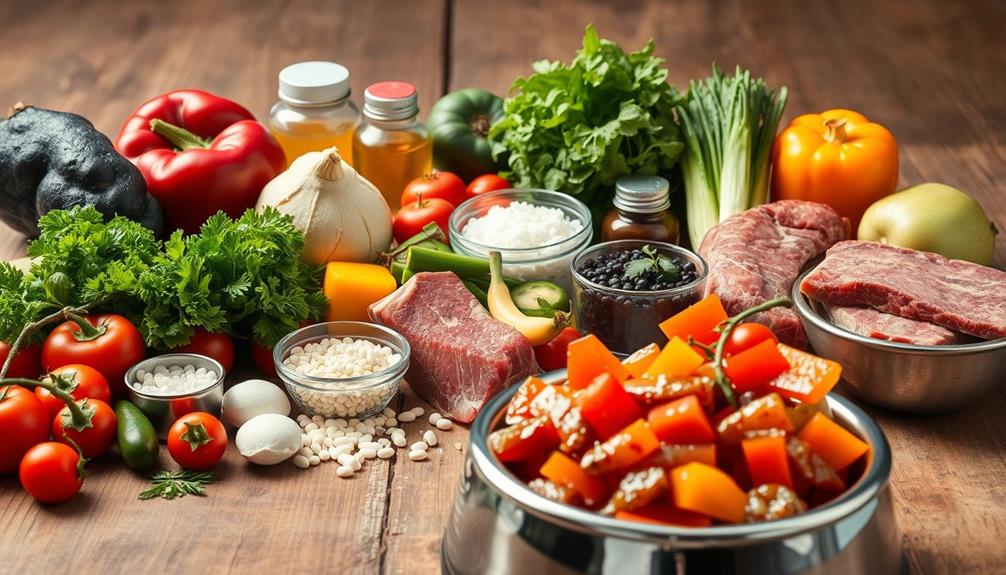
To make your dog's raw meals more enticing, try adding flavor enhancers like cheese or canned sardines.
You can also lightly sear the meat to release mouthwatering aromas that draw them in.
Additionally, consider incorporating some nutrient-rich options like herbal teas that may promote relaxation and overall health.
Experiment with different ingredients to find what your dog loves best and keep their meals exciting!
Flavor Enhancements Techniques
Enhancing the flavor of your dog's raw meals can make a significant difference in their willingness to try new foods. By incorporating some flavor enhancements, you can entice picky eaters and make the shift to a raw diet experience enjoyable.
It's important to remember that just as with financial considerations for elderly care, planning and gradual adjustments can lead to a smoother shift. Here are three effective techniques:
- Add Cheese or Treats: Sprinkle some cheese or your dog's favorite treats on top of their raw meals. This simple addition can boost their excitement and encourage them to dig in.
- Incorporate Nutrient-Rich Options: Mix in canned sardines, low-sodium bone broth, or goat's milk. These not only enhance flavor but also boost nutritional value, ensuring your dog gets a well-rounded diet.
- Experiment with Fruits and Vegetables: Try adding different fruits and veggies to see what excites your dog. This experimentation can help maintain interest and keep their meals fresh and appealing.
As your dog adjusts to raw feeding, gradually decrease the intensity of these flavor enhancements. This approach helps them develop a taste for raw meals without relying solely on strong flavors, making the shift smoother.
Cooking Methods for Aroma
Introducing aroma to your dog's raw meals can greatly boost their interest and appetite. One effective cooking method is lightly searing raw meat. This technique releases enticing aromas that can make the meal more appealing, especially during the shift to raw food.
As your dog becomes accustomed to raw food, gradually reduce the searing to ease them into the new diet without overwhelming their senses. Additionally, understanding different brewing methods can inspire you to explore various ways to enhance your dog's meals creatively.
Always remember to avoid cooking bones, as they can splinter and cause serious digestive issues. Instead, focus on incorporating flavorful additions that enhance aroma and taste. Low-sodium bone broth, goat's milk, and canned sardines are excellent choices that not only improve the meal's scent but also increase its acceptability.
Experimenting with these cooking methods and enhancements can help you identify what excites your dog the most. By creating an enticing aroma, you increase the likelihood of your dog embracing their new diet.
Experimenting With Additions
Experimentation can be a rewarding journey as you discover what makes your dog excited about their raw meals. By incorporating flavorful additions, you enhance the palatability of their diet and entice even the pickiest of eaters.
Understanding your dog's nutrition is essential, as it directly impacts their health and energy levels, just as a well-planned budget does for financial stability. Here are three effective enhancements to take into account:
- Canned Sardines or Low-Sodium Bone Broth: These can elevate the flavor and aroma, making raw food more appealing.
- Goat's Milk or Cheese: These treats can considerably increase your dog's willingness to eat their meals, adding a tasty twist.
- Pureed Vegetables: Experimenting with these can help create a balanced diet while providing essential nutrients.
As you try different additions, remember to monitor your dog's reactions closely. This way, you can tailor their feeding experience to guarantee both enjoyment and nutritional adequacy.
You might even lightly sear the meat initially to release enticing aromas, gradually reducing the cooking as your dog adjusts to raw food.
With a bit of patience and creativity, you'll find the right mix that excites your dog and keeps their diet balanced!
Managing Detox Symptoms

Changing your dog to a raw food diet can bring about some unexpected detox symptoms, which aren't uncommon during this adjustment period. You might notice loose stools, vomiting, or even bad breath as your dog's digestive system adapts.
Incorporating essential oils for respiratory health into your dog's environment may also help alleviate any stress-related symptoms during this changeover. To help manage loose stools, consider adding plain canned pumpkin to their meals; it can aid in achieving a firmer stool consistency.
While mucus-covered stools can be alarming, they often indicate detox and are usually not serious. During this time, make sure your dog has constant access to fresh water, as hydration needs may shift due to the moisture content in raw food.
Monitoring for detox symptoms, such as runny eyes or dry skin, is essential. Keep a close eye on your dog's behavior and physical condition. If you notice any severe symptoms, it's best to seek a consultation with a veterinarian to rule out any underlying issues.
Observing Changes During Transition
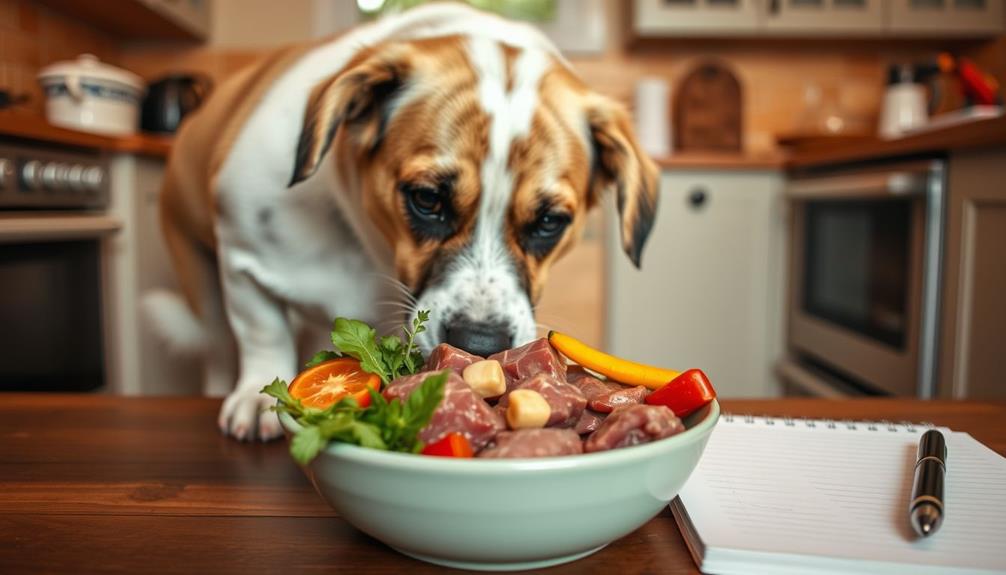
As your dog adjusts to their new raw food diet, you'll want to keep a close watch on various changes in their health and behavior. This shift can lead to some noticeable effects, so being observant is key.
Additionally, understanding how to create an effective bug out bag can also enhance your preparedness for emergencies, which is essential when considering your pet's needs.
Here are three important areas to monitor:
- Changes in Their Stool: Expect smaller and firmer stools as your dog adapts. However, you might also notice loose stools or digestive upset during the shift.
- Energy Levels and Overall Behavior: Keep an eye on your dog's energy levels. If they seem lethargic or unusually hyper, it could indicate that you need to adjust the food ratios.
- Monitoring Your Dog's Water Intake: Since raw food has higher moisture content, your dog may drink less water. Make sure they're staying hydrated, as this is critical for their overall health.
Also, watch for any adverse reactions, like vomiting or diarrhea, which are common detox symptoms but should resolve within a few days.
Benefits of a Raw Diet

Shifting your dog to a raw diet offers a range of benefits that can greatly improve their overall health and well-being. One of the primary advantages is improved digestion and nutrient absorption. Fresh, raw food typically has higher moisture content, promoting ideal gastrointestinal health.
Dogs on a raw diet often enjoy enhanced coat condition, with shinier fur and reduced shedding, thanks to the inclusion of high-quality proteins and essential fatty acids.
Additionally, a raw diet supports stronger immune systems by providing natural enzymes and nutrients that bolster overall health and help reduce the risk of allergies and sensitivities. You'll likely notice smaller and firmer stools, which indicate better digestion and nutrient utilization, as raw food is more bioavailable than processed kibble.
Moreover, many pet owners report positive behavioral changes in their dogs after switching to a raw diet. Increased energy levels and reduced aggression can occur due to improved overall health and nutrition.
Selecting Quality Raw Food
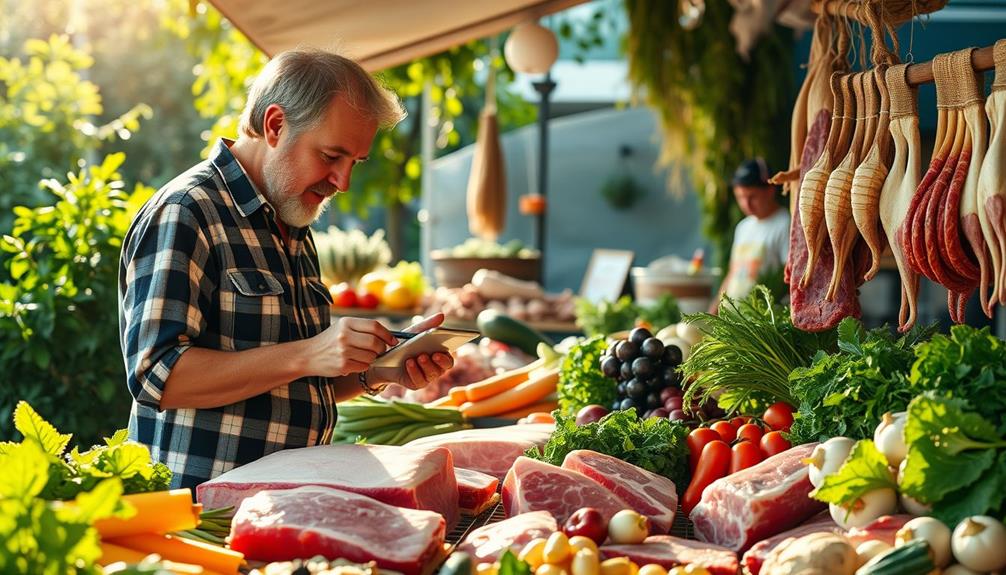
When selecting quality raw food for your dog, it's important to prioritize high-quality ingredients sourced from reputable suppliers. This guarantees ideal nutrition and safety for your pet.
Here are three key factors to take into account:
- Transparency: Choose raw food brands that are open about their sourcing and production methods. This transparency can indicate the quality and safety of their ingredients.
- Complete and Balanced Diet: Verify the raw food diet is complete and balanced, containing a variety of proteins, organ meats, and appropriate supplements. This variety will help meet your dog's specific nutritional needs.
- Health Requirements: Reflect on your dog's breed and life stage. Some formulations are tailored to address common health issues and support overall well-being.
Additionally, stay informed about potential recalls or safety alerts related to raw food brands.
Regularly checking for updates helps protect your dog's health. By focusing on these aspects, you can confidently choose a meat-based diet that meets your dog's nutritional needs and contributes to their overall well-being.
Frequently Asked Questions
How Long Does It Take a Dog to Adjust to Raw Food?
It usually takes a dog about 7 to 10 days to adjust to raw food. However, younger dogs might adapt in just 1 to 2 days, while older dogs may need up to 6 weeks.
How Should I Introduce Raw Food to My Dog?
When it comes to introducing raw food, remember: "Slow and steady wins the race." Start with small amounts, mix it with kibble, and gradually increase the raw portion while keeping an eye on your dog's reaction.
How Do I Prepare My Dog for a Raw Diet?
To prepare your dog for a raw diet, start slowly by introducing small amounts of raw food alongside their regular kibble. Monitor their reaction, adjust portions, and guarantee fresh water is always available for hydration.
Do Dogs Detox When Switching to Raw?
When switching your dog to raw food, you might notice detox symptoms like loose stools or bad breath. These usually pass within a week, so keep an eye on hydration and consult your vet if needed.
Conclusion
Shifting your dog to a raw food diet can seem intimidating, but with patience and the right approach, it can be a smooth journey. Remember, it's all about taking baby steps—no need to rush like you're in a race against time. Keep an eye on your pup's reactions, and soon enough, you'll see the benefits of a healthier diet. So, roll up your sleeves, and give your furry friend the gift of good nutrition!

